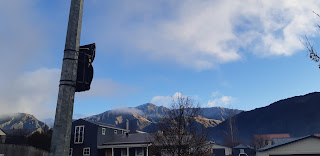New Zealand’s unhealthy home-heating in the age of COVID-19: Part 4 Has COVID-19 lockdown changed the risk from woodsmoke?
Winter 2020 may be different to
previous winters. During level-4 lockdown, many more people were at home for
more hours of the day. This was probably little changed in level-3. It is
plausible to assume not only does this mean more people spending extended time
in places where they are likely to be inhaling woodsmoke, it also means
fireplaces are on for longer, more wood being burned and more smoke in the air.

Home heating emissions usually
start to impact air quality from around mid-April, with each cold snap being a
little colder and PM10 levels a little higher. At the time of writing, PM10
levels across communities with well-known woodsmoke issues “appear” (at first
glance) to be about normal for the time of year, or maybe very slightly down.
However, deducing what is happening with emissions (the amount of smoke being
released from chimneys into the air) from air quality data (how concentrated
that smoke is after its been diluted, transported and reaches a monitor, or
someone’s nose) alone is surprisingly difficult. On a day-to-day basis air
quality varies hugely depending on the weather - especially the wind speed.
Each year people will discuss how winter has come early, or late, or is
warmer/colder than normal. It really takes several weeks or even months of data
before analysts can draw even tentative conclusions about whether fluctuations
in air quality means that emissions have changed or if the variation is just a
reflection of capricious weather.
 |
| PM10 in Invercargill during level-4 (orange) and level- 3 (yellow) in 2020, and same weeks in 2019 |
These are some of the reasons why
NIWA’s “CONA” research project exists. The Community Observation Networks forAir project was born in 2015. It’s aim is to explore how new technologies might
increase our understanding of local air quality – mainly by expanding what can
be observed – and trial how that understanding can be used by communities to
accelerate solutions. Over the last five winters the NIWA team have developed
new techniques for using low-cost sensors in the streets and in the home for
tracking the sources and movement of smoke across towns. We have also
experimented with using apps to enable local householders and schoolchildren to
capture data on who the smoke is affecting.
 |
| An ODIN in Arrowtown |
After a successful project in
Arrowtown in 2019, the NIWA team were almost ready to return to the town, this
time recruiting a team of local volunteers to help run the project and begin
some small intervention experiments. But COVID-19 beat us to it. The virus, and
the lockdown – whilst frustrating – provided us with some new research
questions and opportunities. As we emerge from level-3 into level 2 this week,
the NIWA team is getting ready to get back to work.
What happens with woodsmoke
emissions during level-2 and beyond depends on whether we need to return to
level-3 or 4, and on the economic fallout from lockdown. How many people who
would normally be out working now be stuck at home? How many will find
themselves unable to afford wood and find themselves condemned to the double
risk of a cold home but no escape from their neighbour’s smoke?
Our first tasks include launching
an app that anyone can use to report the impact woodsmoke is having on them.
This is intended to start building up a picture of these previously unreported
‘invisible’ impacts, and possibly identify locations which need special
attention in the future.
 |
| NIWA's Citizen Science app |
Once fieldwork can re-start in
earnest, we intend to pay particular attention to helping communities to
monitor their own wood consumption, smoke emissions and impacts. This then
provide a platform for developing, trialling and perfecting solutions to
creating healthy communities that also provide safe havens from environmental
hazards.
Comments
Post a Comment